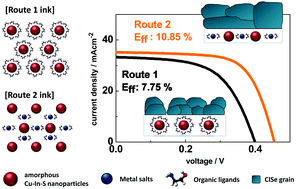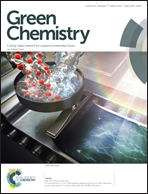An amorphous Cu–In–S nanoparticle-based precursor ink with improved atom economy for CuInSe2 solar cells with 10.85% efficiency†
Abstract
An amorphous Cu–In–S nanoparticle-based precursor ink with improved atom economy was developed in which a large amount of bulky organic ligands was replaced with metal salt–organic ligand complexes. This change resulted in a reduction of the required amount of organic ligands in the ink, meaning that additional spaces in the green layer were occupied by constituent metal atoms rather than organic ligands. Using modified amorphous Cu–In–S nanoparticle inks containing metal salt–organic ligand complexes, improvement of the morphologies of selenized CuInSe2 thin films was observed in terms of greater compactness, better flatness, and larger grains, which led to an increase in the device efficiency to 10.85%. This result demonstrates that even with low-quality precursor materials, such as amorphous Cu–In–S nanoparticles, proper control of the atom economy of the precursor inks enables the facile fabrication of high-quality inorganic semiconductor films and devices at low cost.



 Please wait while we load your content...
Please wait while we load your content...